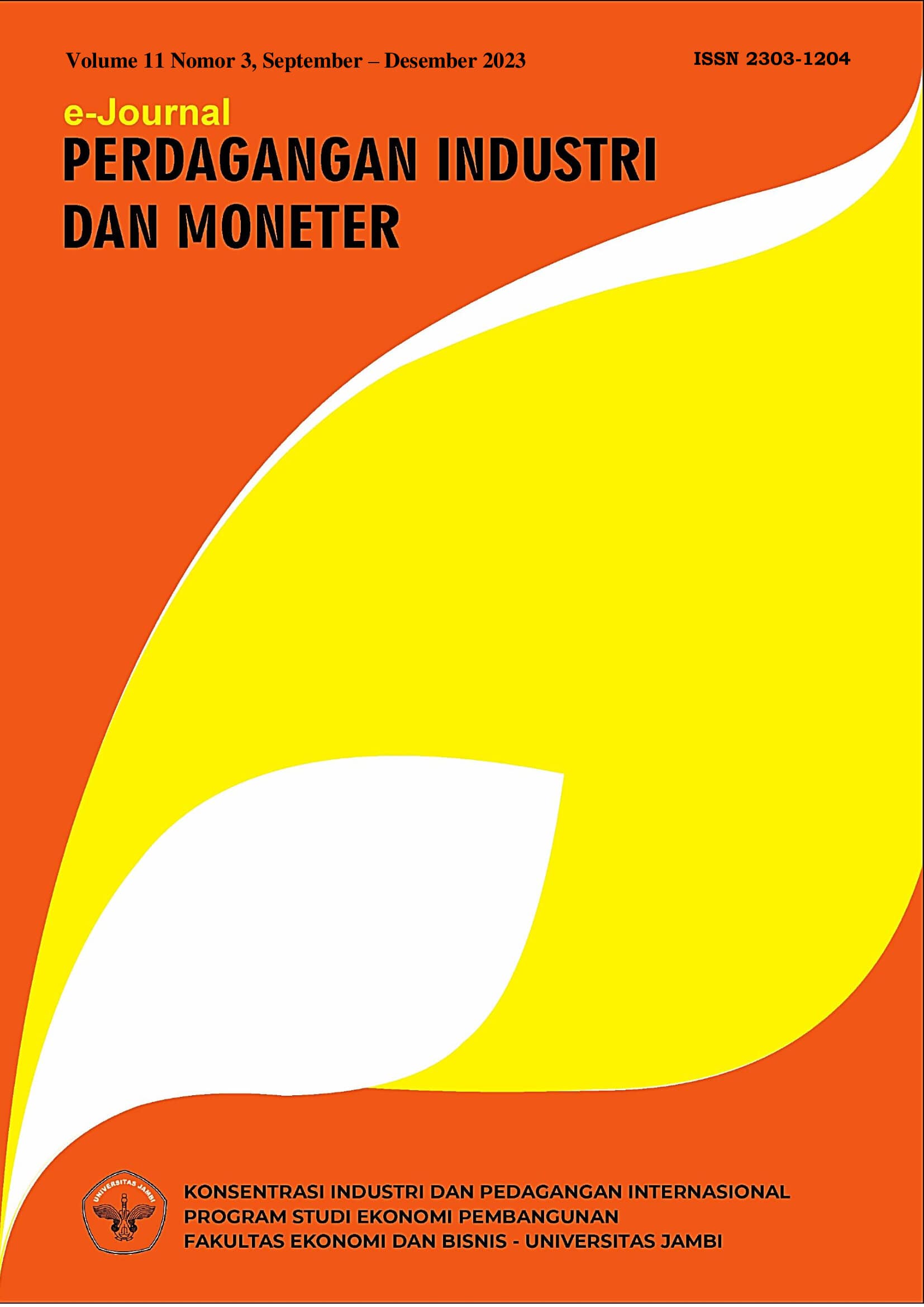Pengaruh e-money, tingkat suku bunga dan inflasi terhadap jumlah uang beredar di Indonesia
DOI:
https://doi.org/10.22437/pim.v11i3.29666Keywords:
money supply, e-money, interest rates, inflationAbstract
This research aims to: 1) analyze developments in the money supply, e-money, interest rates and inflation in Indonesia. 2) analyze the influence of e-money, interest rates and inflation on the money supply in Indonesia. This research uses time series data, research period 2009 I-IV – 2022 I-IV. The analytical tools used are descriptive statistics and Autoregressive Distributed Lag (ARDL) regression. The results of this research show that: 1) developments in the money supply, e-money, interest rates and inflation in Indonesia fluctuate. 2) Based on the regression results, the results show that e-money, interest rates and inflation have a significant effect on the amount of money circulating in Indonesia.
Downloads
References
Aksami, D., & Jember, I. made. (2019). Analisis minat penggunaan layanan e-money pada masyarakat Kota Denpasar. E-Jounral Ekonomi Pembangunan Universitas Udayana, 8 No.10, 2439–2470.
Aksami, D., & Jember, I. made. (2019). Analisis minat penggunaan layanan e-money pada masyarakat Kota Denpasar. E-Jounral Ekonomi Pembangunan Universitas Udayana, 8 No.10, 2439–2470.
Amanah, F., Juliprijanto, W., & Prasetyanto, P. K. (2019). Giro wajib minimum terhadap jumlah uang beredar di Indonesia Tahun 2005-2019 Analysis of the Impact of Inflation , Interests Rate and. DINAMIC: Directory Journal of Economic Vol 2, 2.
Azhar, Z., Putra, H. S., & Huljannah, M. (2020). Implications of using e-money and apmk on the money supply: the case of Indonesia. Proceedings of the 5th Padang International Conference On Economics Education, Economics, Business and Management, Accounting and Entrepreneurship (PICEEBA-5 2020), 152, 209–220. https://doi.org/10.2991/aebmr.k.201126.025
Chen, L., Jiang, M., & Zhao, L. (2012). Sebuah studi empiris tentang pengaruh uang elektronik terhadap pengganda uang - analisis berdasarkan data Cina dari 1990-2009. 122–128.
Djohanputro, B. (2008). Prinsip-prinsip Ekonomi Makro (2nd ed.). PPM Manajemen.
Firnandes, F., Rosyetti, & Richard, R. (2014). Pengaruh uang giral dan uang kuasi terhadap inflasi di Indonesia. Jurnal Online Mahasiswa Fakultas Ekonomi, Vol.1 No.2, 1–15.
Gujarati, D. N., & Porter, D. C. (2012). Dasar-dasar Ekonometrika Buku 2. Salemba Empat.
Hastuti, D. ., Edhie Purnawan, M. ., & Sunargo, S. (2019). Pengaruh variabel-variabel di sektor riil dan perbankan terhadap Shock Credit Default Swap (CDS) di Indonesia . E-Journal Perdagangan Industri Dan Moneter, 7(3), 185 - 204. https://doi.org/10.22437/pim.v7i3.13071
Ihsan, I., & Anjum, S. (2013). Impact of money supply on GDP of Pakistan. Global Journal of Management and Business Research, 2–9.
Istanto, L., & Fauzie, S. (2014). Analisis dampak pembayaran non tunai terhadap jumlah uang beredar di Indonesia. Jurnal Ekonomi Dan Keuangan, Vol.2 No.1, 610–621.
Jamilah, K. R. (2021). Ekonomi moneter dan keuangan islam. FEBI UIN_SU Press.
Judisseno, R. K. (2002). Sistem Moneter dan Perbankan di Indonesia. Gramedia Pustaka Utama.
Jumhur. (2020). Penerapan autoregressive distributed lag dalam memodelkan pengaruh inflasi, pertumbuhan ekonomi dan FDI terhadap pengangguran di Indonesia. Jurnal Ekonomi, Bisnis Dan Kewirausahaan (JEBIK, 9(3), 250–265.
Luhgede, N., Luwihadi, A., & Arka, S. (2014). Determinan jumlah uang beredar dan tingkat inflasi di Indonesia periode 1984-2014. E-Journal EP Unud, 6(4), 533–563.
Mahdi Igamo, A., & Aulia Falianty, T. (2018). The impact of electronic money on the efficiency of the payment system and the substitution of cash in Indonesia. Sriwijaya International Journal Of of Dynamic Economics and Business, Sijdeb, 2(3), 237–254. http://ejournal.unsri.ac.id/index.php/sijdeb
Maria, J. A., Sedana, I. B. P., & Artini, L. G. S. (2017). Pengaruh tingkat suku bunga, inflasi dan pertumbuhan gross domestic product terhadap jumlah uang beredar di Timor Leste. E-Journal EP Unud, 3477–3514.
Nirmala, T., & Widodo, T. (2011). Effect of increasing use the card payment equipment on the indonesian economy. Jurnal Bisnis Dan Ekonomi (JBE), 18(1), 36–45.
Nizam, A. M. (2022). Impact of e-money on money supply: Estimation and policy implication for Bangladesh. PLoS ONE, 17(4 April), 1–18. https://doi.org/10.1371/journal.pone.0267595
Nopirin. (2007). Ekonomi moneter: buku 1. BFE Yogyakarta.
Polontalo, F., Rotinsulu, T. O., & Maramis, M. T. . (2018). Analisis faktor – faktor yang mempengaruhi permintaan uang di Indonesia Periode 2010.1 – 2017.4. Jurnal Berkala Ilmiah Efisiensi, 18(3), 35–46. Prawoto, N. (2019). Pengantar Ekonomi Makro. PT RajaGrafindo persada.
Prawoto, N. (2019). Pengantar ekonomi makro. PT RajaGrafindo persada.
Puspitasari, A. N. F., Rotinsulu, T. O., & Niode, A. O. (2021). Analisis pengaruh transaksi pembayaran non tunai terhadap jumlah uang beredar M1 di Indonesis Tahun 2009-2019. Jurnal EMBA: Jurnal Riset Ekonomi, Manajemen, Bisnis, Ekonomi, dan Akuntansi, 9, 523–532.
Rahardja, P., & Manurung, M. (2019). Pengantar ilmu ekonomi : (mikroekonomi & makroekonomi) (Edisi 4). Salemba Empat.
Saputri, N. M. M. D., Jayawarsa, A. A. K., & Wulandari, I. G. A. A. (2020). Pengaruh inflasi dan BI rate terhadap simpanan masyarakat pada bank umum pemerintah di Indonesia Tahun 2009-2018. Warmadewa Economic Development Journal, vol.3 no., 65–72.
Suta Sancaya, K., & Wenagama, W. (2019). Pengaruh tingkat suku bunga, tingkat inflasi, kurs dollar AS terhadap jumlah uang beredar di Indonesia. E-Journal EP Unud, 8(4), 703–734.
Tambunan, T. T. H. (2011). Perekonomian Indonesia : kajian teoretis dan analisis empiris (R. Sikumbang (Ed.)). Ghalia Indonesia.
Wulan Sari, S. (2016). Perkembangan dan pemikiran uang dari masa ke masa.
Yuli Wijaya, A., Mukhlis, I., & Seprillina, L. (2021). Analisis pengaruh E-money, volume transaksi elektronik dan suku bunga terhadap jumlah uang beredar di Indonesia pada masa sebelum dan sesudah pandemi COVID-19. Jurnal Ekonomi, Bisnis Dan Pendidikan, 1(2), 135–145. https://doi.org/10.17977/um066v1i22021p135-145
Zakaria, J. (2009). Pengantar teori ekonomi makro. Gaung Persada (GP Press).
Zunaitin, E., Niken W, R., & Wahyu P, F. (2017). Pengaruh E-money terhadap Inflasi di Indonesia. Journal Ekuilibrium, 2(1), 18–23.
Zamzami, Z., Hastuti, D., & Sunargo, S. (2020). Pengaruh ekspor Asia Timur terhadap pengangguran di Indonesia . Jurnal Paradigma Ekonomika, 15(1), 59-74. https://doi.org/10.22437/jpe.v15i1.9220
Downloads
Published
How to Cite
Issue
Section
License
Copyright (c) 2022 Evi Sinta Uli Naibaho, Siti Hodijah, Zainul Bahri

This work is licensed under a Creative Commons Attribution-ShareAlike 4.0 International License.








